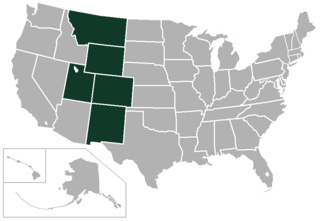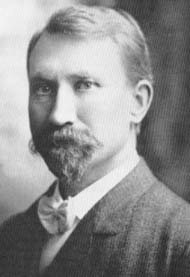
U.S. Route 85 (US 85) is a 1,479-mile-long (2,380 km) north–south United States Highway that travels in the Mountain and Northern Plains states of the United States. The southern terminus of the highway is at the Mexican border in El Paso, Texas, connecting with Mexican Federal Highway 45. The northern terminus is at the Canadian border in Fortuna, North Dakota, where the route continues north as Saskatchewan Highway 35. The highway route is part of the CanAm Highway. Sections of US 85 are designated as the Theodore Roosevelt Expressway.

The Sioux Wars were a series of conflicts between the United States and various subgroups of the Sioux people which occurred in the later half of the 19th century. The earliest conflict came in 1854 when a fight broke out at Fort Laramie in Wyoming, when Sioux warriors killed 31 American soldiers in the Grattan Massacre, and the final came in 1890 during the Ghost Dance War.

The Skyline Conference was a college athletic conference based in the Western United States that was active from December 1937 to June 1962. The conference's formal name was the Mountain States Athletic Conference, although it was also known as the Mountain States Conference along with informal but popular nicknames. It is unrelated to the contemporary Skyline Conference that is active in NCAA Division III in the New York City area.
Wyoming PBS is the statewide public broadcaster, part of PBS, for the U.S. state of Wyoming. Wyoming PBS is owned and operated by Central Wyoming College and originates from its campus in Riverton. Three high-power transmitters—KCWC-DT in Lander, KWYP-DT in Laramie, and KPTW in Casper—and 40 low-power translator stations broadcast the signal across the state.

Per Axel Rydberg was a Swedish-born, American botanist who was the first curator of the New York Botanical Garden Herbarium.

Ralph Fielding "Hutch" Hutchinson was an American football, basketball, and baseball player. He served as the head football coach at Dickinson College (1901), the University of Texas at Austin (1903–1905), the University of New Mexico (1911–1916), Washington & Jefferson College (1918), the University of Idaho (1919), and the Idaho Technical Institute (1920–1927), compiling a career college football record of 62–55–6. Hutchinson was also the head basketball coach at New Mexico (1910–1917), Idaho (1919–1920), and Idaho Technical (1926–1927), amassing a career college basketball record of 56–18, and the head baseball coach at Texas from 1904 to 1906 and at New Mexico from 1910 to 1917, tallying a career college baseball mark of 69–44–2.
The Association of Public and Land-grant Universities (APLU) is a research, policy, and advocacy organization of public research universities, land-grant institutions, state university systems, and higher education organizations. It has member campuses in all of the United States as well as the District of Columbia, four U.S. territories, Canada, and Mexico.

The Western Athletic Conference Men's Basketball Player of the Year is an award given to the Western Athletic Conference's (WAC) most outstanding player. The award was first given following the 1980–81 season. Keith Van Horn of Utah and Nick Fazekas of Nevada are the only players to have won the award three times. Three other players—Michael Cage, Josh Grant and Melvin Ely—have won the award twice. Danny Ainge, the first ever WAC Player of the Year, was also the John R. Wooden Award winner in 1980–81.
The following television stations broadcast on digital channel 26 in the United States:
The 1938 New Mexico A&M Aggies football team was an American football team that represented New Mexico College of Agriculture and Mechanical Arts as a member of the Border Conference during the 1938 college football season. In their tenth year under head coach Jerry Hines, the Aggies compiled a 7–2 record, was recognized as a conference co-champion, and outscored opponents by a total of 166 to 75. The team played its five home games at Quesenberry Field in Las Cruces, New Mexico.
Vaughn D. Corley was an American football coach. He served as the head football coach at New Mexico College of Agriculture and Mechanic Arts—now known as New Mexico State University—from 1948 to 1950, compiling a record of 9–20. Corley played football and ran track at Texas Technological College—now known as Texas Tech University. He began his coaching career in 1929 at Las Cruces High School in Las Cruces, New Mexico. Corley moved to New Mexico A&M as an assistant football coach in 1933 and coached the linemen there under head coach Jerry Hines until 1938. He coached the line at the University of Oregon, from 1939 to 1942 and again from 1945 to 1946, and at the University of Arizona in 1947 before returning to Mexico A&M as head coach in 1948. Corley also coached at the Saint Mary's Pre-Flight School during World War II.
James Carlin Bradley was an American football coach. He served as the head football coach at New Mexico State University from 1973 to 1977, compiling a record of 23–31–1. Bradley played college football at New Mexico State from 1951 to 1954, when the school was known as New Mexico College of Agriculture and Mechanic Arts. He was the head football coach at Mayfield High School in Las Cruces, New Mexico from 1965 to 1972. Bradley was the head football coach at Roswell High School in Roswell, New Mexico from 1980 to 1993 before he turned to Mayfield High School, where he was again head football coach from 1994 until his retirement in 2005. Bradley was born on March 8, 1933, in Las Cruces. He died in his hometown on August 12, 2015.

Foster Hall is a historic building on the campus of New Mexico State University in Las Cruces, New Mexico. It was built in 1930 to add more classrooms on campus, and it was named for a former professor, Luther Foster, who served as NMSU's president from 1901 to 1908. The building was designed by Braunton & McGhee in the Spanish Colonial Revival and Baroque Revival architectural styles. It has been listed on the National Register of Historic Places since May 16, 1989.
The 1946 New Mexico A&M Aggies football team was an American football team that represented New Mexico College of Agriculture and Mechanical Arts as a member of the Border Conference during the 1946 college football season. In its first year under head coach Raymond A. Curfman, the team compiled a 4–5 record and outscored opponents by a total of 155 to 154. The team played home games at Quesenberry Field in Las Cruces, New Mexico.
The 1955 New Mexico A&M Aggies football team was an American football team that represented New Mexico College of Agriculture and Mechanical Arts as a member of the Border Conference during the 1955 college football season. In their first year under head coach Tony Cavallo, the Aggies compiled a 3–7 record, finished last in the conference, and were outscored by a total of 226 to 141. The team played home games at Memorial Stadium in Las Cruces, New Mexico.

Fabián García was a Mexican-American horticulturist who has been described as "the father of the New Mexican food industry". Among other things, he helped to develop new varieties of chile peppers, pecans, and onions that are still grown in New Mexico. For example, in 1921, he introduced the "New Mexico No. 9", a strain of chile pepper which became the genetic ancestor of all New Mexico chiles.

Martin Van Buren Boughton, more commonly referred to as M. V. Boughton, was an American pioneer and politician who served as the 7th Mayor of Cheyenne, Wyoming.
The 1928 North Dakota Agricultural Bison football team was an American football team that represented North Dakota Agricultural College in the North Central Conference (NCC) during the 1928 college football season. In its sixth season under head coach Stanley Borleske, the team compiled a 3–4–1 record and finished in a three-way tie for third/last place out of five teams in the NCC. The team played its home games at Dacotah Field in Fargo, North Dakota.
The 1946 North Dakota Agricultural Bison football team was an American football team that represented North Dakota Agricultural College in the North Central Conference (NCC) during the 1946 college football season. In its second season under head coach Stan Kostka, the team compiled a 5–3 record and finished in second place out of seven teams the NCC. The team played its home games at Dacotah Field in Fargo, North Dakota.









